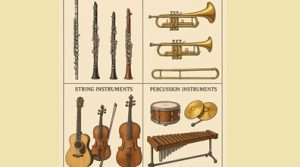Viola vs Violin: 7 Key Differences for String Player
Viola vs Violin: 7 Key Differences for String Players
Aspirants thinking of pursuing the viola or violin should consider the 7 important differences every string musician should understand.

At a cursory view, the violin and viola appear very closely related, but once explored, distinguishing factors make one key to every string musician.
Ranging from size and tuning to their use in orchestras, these two instruments have completely distinct roles to play in their own right.
Viola vs Violin: So What Makes the Violin Different from the Viola?
The first and most easy difference observed? Size. The viola is a little bit larger than the violin and hence produces a tone deeper and richer than that of the violin.
The violin, being smaller and tuned higher, has a much brighter and piercing sound. Their string tuning is different (both tuned in fifths), too; violists read from the alto clef, while the violinist reads from the treble clef.
Even their bows are different—there is some extra weight and different shaping for the viola bow in comparison to the violin bow.
Which Came First – The Violin or the Viola?
Both branches: from the viola da braccio came viola and violin, while the viola da gamba evolved into other instruments such as the cello.
Hence, nobody may be sure as to which instrument came first, but it appears likely that the viola came on its way first.
Viola vs Violin: Zooming in on the Differences
Although they share similar roots and appearances, all in all, the violin and the viola differ from one another in very key aspects:
Size
The violin is the smallest in the family of orchestral string instruments. Body length may vary from anywhere between 8″ and 14″
They lend additional width and depth to the body, which aids in providing a mellow tone.
Strings and Tuning
While both instruments are tuned in intervals of fifths, the actual tunings differ. The violin is tuned, from low string upward, to G-D-A-E; the viola starts a fifth lower: C-G-D-A.
The strings may be made of similar materials, often synthetic or gut cores with metal winding, but viola strings, being longer and thicker, need more bow pressure for sound production.
Bows
At the first glance, the bows of violin and viola appear to be identical, simple flexible sticks, usually of wood or carbon fiber, with horsehair (natural or synthetic) and a frog for grip and balance; look a little closer, however, and you’ll find some important differences.
Both bows are about the same length, but a viola bow is noticeably heavier. This added weight assists in affecting the force to play the thicker strings of a viola.
Viola bows can also be calibrated with wider hair ribbons to better complement the resonance and tone production of the instrument. Even the frog portion of the bow, which is held by the player, has some slight differences.
On straight edges end, the frogs would be violin, while those of viola have a more curved design comfortable ergonomically, better suited for longer periods.
Sound
The distinct sound qualities of violins and violas have a lot to do with their size and string tuning.
Smaller, lighter strings and a tighter body cavity produce a bright, clear, and punchy tone powerful enough to cut above the orchestra; all this makes violins admirable for leading melodies and solo passages. A deeper and warmer sound with a larger body cavity and thicker strings comes from the wider body of the viola.
Its tune is lower, hence resonates on a slower rate, making it rich and mellow and enhancing higher voices within an ensemble.
The sound from a viola is not as piercing as that of a violin, but it gives depth that can nurture the harmony and add texture.
Clef
Differs in the clefs reading between these two instruments, which can also be rather confusing to a beginner.
The clef used by violin is treble clef (or G clef), the most widely used clef in music notation.
That is for only higher-pitched instruments, which are generally acquainted with very early in music teaching.
The primary clef that the viola uses is the alto clef (c clef); a very distinctive clef -one of the few that almost only apply to one instrument-because of this, most other instrumentalists play at the alto clef and learn to read in this unfamiliar clef.
Orchestral Seating
Within an orchestra, seating reflects each instrument’s role and tonal range, whereby viola players are placed in the middle of the ensemble.
While long acknowledged for its superior capabilities, lately, the warm lyrical tone of violaolas has been audaciously gaining greater prominence.
Musical Role
The violin stands out in both orchestral and solo settings.
It is brilliant for carrying melodies and is featured in countless solo compositions, concertos, and chamber works due to its high pitch and brilliant agility.
The viola was a more subdued instrument in the earlier music, but it has been contributing since its beginning.
While long acknowledged for its superior capabilities, lately, the warm lyrical tone of the viola has been audaciously gaining greater prominence.
How to Choose the Right Instrument for You
Choose What Is Just Right for You
Your actual choice between the violin and viola depends a lot on your musical goals and personality.
- The violin is very versatile; it has great solo and ensemble repertoires and often finds its way into classical, pop, jazz, and even film music. If a child (or you!) desires to do a lot of solos, fast passages, or be in the spotlight, this is a good fit.
- On the other hand, the viola is a less-traveled road. The number of violists is fewer, especially in student-oriented orchestras; hence it means more opportunities and less competition.
It has a delightful, rounded tone that supports the treble and appeals mostly to players that enjoy being in a harmonic or supportive role.
Some of the abilities learned on the violin transfer to the viola, so it’s not uncommon that they switch later on; still, the viola is not just a bigger violin; it has its voice and personality.
Insights into History
The history of bowed stringed instruments stretches across continents and centuries. Instruments like the rebab, in use in parts of Africa and Asia as early as the 8th century, retain modern parallels in the design and playing style with some bowed instruments.
The European family of violins and violas can trace their forebears from the lira da braccio, a stringed instrument of the Renaissance that became, by way of evolution and alteration, the mother of almost all modern orchestral string instruments.
FAQs
Which instrument is easier to play: the violin or viola?
Each has its challenges. The violin is lighter, which may provide more comfort for smaller players; however, it does tend to have music that is technically more challenging.
The viola, however, is somewhat heavier, has less complicated beginner pieces, has a deeper and more forgiving sound, and avoids some of the shriller sounds noted in the earlier days of violin playing.
Should I start with the violin or viola?
Most beginner students learn on the violin. The violin is more available in smaller sizes and has a lot more resources for learning.
But if you have a nice-sized viola and you like the sound, that would be a great instrument for a beginner as well. Don’t be held back by tradition!
Can a violinist play viola?
Yes, with some readjustments. The instruments do not look so different at first; however, the playing of the viola requires balancing oneself to a different way of holding and bowing weight compared to the violin’s more usual way, plus reading a different clef.
The violists read the alto clef, which is something many violinists will not have been accustomed to.
Many skills transfer freely within, and generally, it seems to be an easy transition for high-level players.
What are the string names on a viola? How many does it have?
C, G, D, and A are the names of the strings of a viola. How many does it have?
A viola is made up of four strings tuned in fifths: C, G, D, and A from lowest to highest. This gives the viola a warm, rich sound that places it right under the violin in range.
Which types of viola strings are there?
Like violins do, viola strings generally come in three types:
- Steel core – bright and focused sound, great for beginners or ensemble playing.
- Synthetic core – warm and gut-like tone with added stability.
- Gut core – traditional, warm, and rich but sensitive to temperature and humidity.
What you select finally depends on the particulars of your style of music, your experience level, and, of course, your budget.

Final Thoughts on Viola vs Violin:
We hope this guide has clarified some of the delightful differences between the violin and the viola.
Although sharing the same family of instruments, each has its character in the orchestra, colored by a tapestry of differing size, sound, and playing style.
If your heart is stirred by bright, ecstatic melodies and enjoys being the highlight, the violin will most likely feel like an extension of yourself.
On the contrary, for those who prefer a darker, fuller sonority that harmonizes well and hangs on for dear life against melody, the viola could be considered a home within your heart.
A lot of people out there engage in dalliances with both instruments at one time or another, either for study, performance, or just plain fun.
There may be many things in common, but each one has a unique personality that requires a different approach and feel.
Therefore, choosing between the two is not simply about sound or size; it’s about your complete immersion into the music with one or the other!
It does not matter much whether the violin brightens your day or the viola warms your heart; either way, knowing these differences across both genres adds to the great experience of your musical life.
So whatever door you choose to walk through, know now that you are stepping into another world: a world of inspiration, creativity, and challenges that will hold your hand through the journey.





